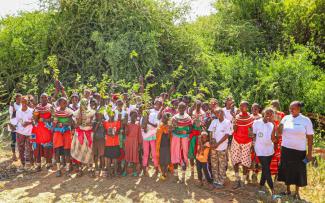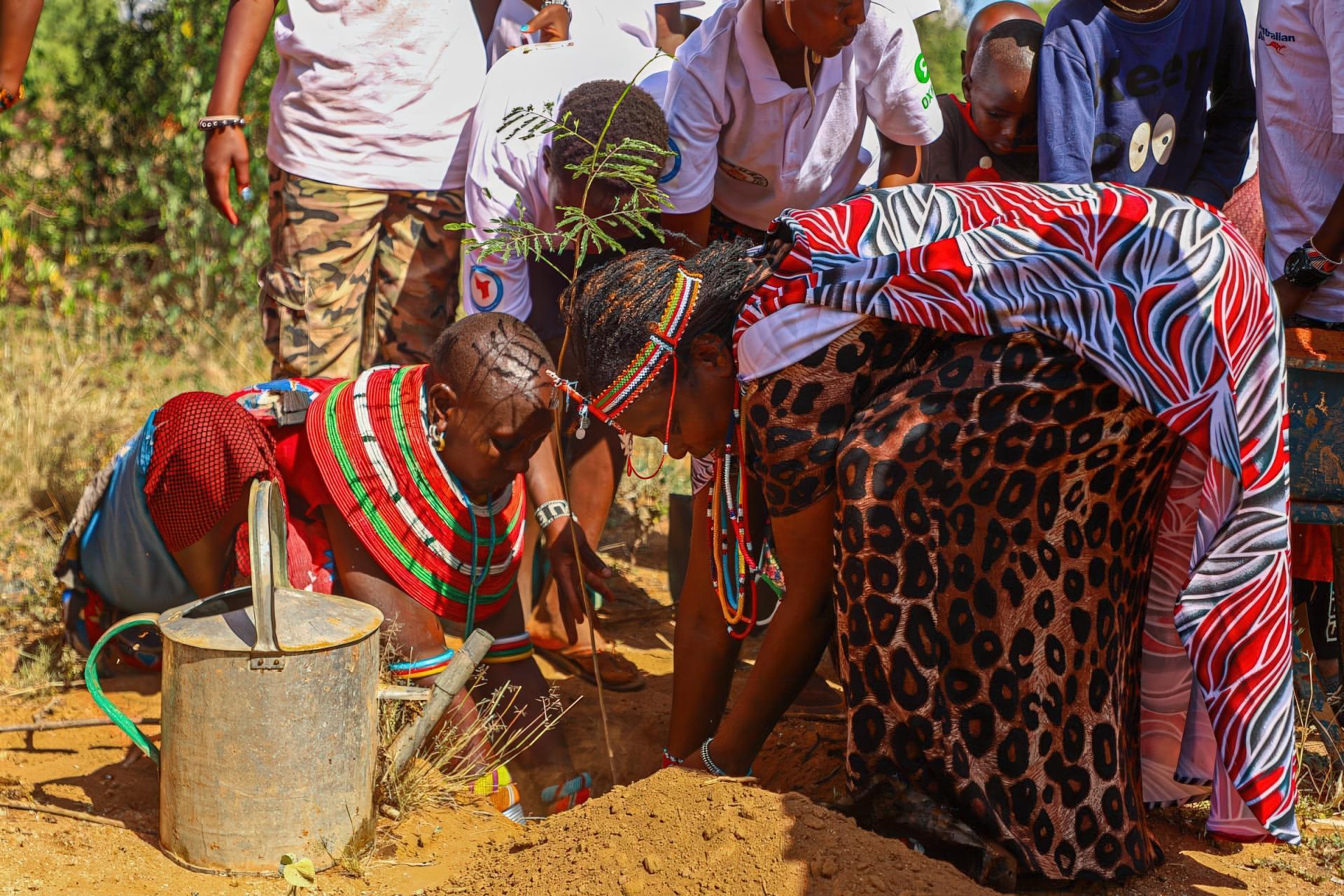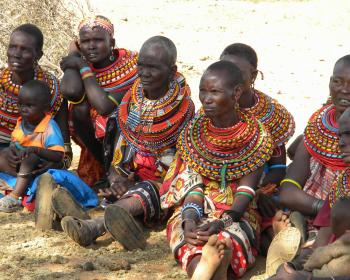
The Samburu and Turkana Indigenous communities in Kipsing, Isiolo County, northern Kenya are pastoralists who rely on livestock keeping for survival. Pastoralism is essential not only for meeting their basic needs, such as sending children to school, but also for maintaining their traditional lifestyles. However, due to the devastating impacts of climate change, particularly the severe drought that has lasted for more than three years—the longest since 1997—the pastoralists have been forced to sell goats and sheep for cattle feed, and over 95% of their livestock has been lost through drought and ethnic conflicts. The few cattle that survived the drought were later swept away by severe floods, which also destroyed the small manyattas (traditional homesteads) of the communities, leaving people extremely vulnerable. Their primary source of livelihood was cut off, their homes demolished, and their household items carried away by the floods.
Recognizing the gravity of this situation, Samburu Women Trust donated a 10-acre piece of land to establish the Namarat Indigenous Women’s Arboretum. By partnering with the communities in Kipsing, they are working to restore hope and protect women and young girls in particular from the impacts and vulnerabilities of climate change. Together, they have brainstormed and developed alternative survival strategies for these women and girls. The nomadic communities who live in the savannah drylands understand well the effects of drought and how floods have impacted the day-to-day life of local communities. They have the skills, knowledge, and solutions to address increasingly unpredictable weather and protect their ecosystem.
The name Naramat is associated with women as custodians of the environment. The arboretum serves as a hub for Indigenous women; it is an agroecology demonstration center for native seeds, preserving native plants of medicinal value that are threatened to become extinct in the Indigenous landscapes, thereby restoring the land and protecting the region’s biodiversity. In pastoralist communities, plants hold great cultural and spiritual importance. Without these plants, essential cultural rituals like initiations, marriages, and child naming would not be possible.

Traditional herbs used for treating illnesses are crucial for the community’s well being. Thus, the arboretum was created to restore the land, safeguard the endangered species, and protect the local biodiversity. Due to climate change, many important plants have disappeared from certain areas, forcing people to travel long distances to fetch them. The Naramat Arboretum serves as a center for conserving and protecting these essential plants. It also provides a space for nature-based practices that Indigenous women are already engaged in through knowledge transfer from Elders to younger generations and empowerment programs. It will also serve as a nomadic school for Indigenous women, tapping into their rich Traditional Knowledge and passing it on to students, youth, researchers, and the university to incorporate the pastoralism and nomadic lifeways. Elders will teach the community about cultural materials and demonstrate their use. This center will also be a tourist attraction, drawing visitors from across the country and the world to explore the Samburus’ rich cultural heritage. The income generated will be reinvested in supporting Indigenous women.
As the world begins to return to herbal medicine, it is crucial to re-evaluate the wealth of Traditional Knowledge surrounding traditional remedies. Two plants of particular significance are Acacia nilotica (Lkiloriti) and Acacia tortilis (Ntepes). Acacia nilotica, known as Lkiloriti in Samburu language, is an Indigenous tree found in Kenya and East Africa that plays a vital role in the Maasai and Samburu communities. The Lkiloriti tree has long been utilized in Samburu communities for its wide array of medicinal benefits, with all parts of the plant being employed to treat various ailments. Its medicinal uses include treating diabetes, ulcers, wounds, dry and persistent coughs, and asthma. It has anti-inflammatory, anti-oxidant, antibacterial properties, and can be used to manage hypertension. The seeds of the Lkiloriti are used to treat oral issues, and are also ground and used in porridge to promote overall health and wellness. The leaves are consumed by goats and camels, offering both nutrients and health benefits. The yellow flowers of the tree are a key element for bees to produce honey, adding flavor. Once the flowers mature, they shed and become food for goats. The inner part of the bark is boiled in water or made into soup, or roasted and ground to treat coughs, improve digestion, and enhance general health.
The Acacia tortillis tree, commonly known as the Umbrella Thorn, or Ntepes in the Samburu language, serves as a key gathering point during conflict resolution and discussion of important community matters. The Ntepes tree is widely distributed across northern Kenya, thriving in arid savannah regions. It is known for its distinctive umbrella-shaped canopy, which provides shelter against the harsh sun, and its ability to withstand extreme heat, drought, and dry soil conditions. Its broad canopy provides essential shade for livestock during the hot, dry periods, offering relief from the scorching sun as well as a primary food source for domesticated grazing animals such as camels and goats. The tree’s leaves and seed pods (known as sagaram) are a valuable source of nutrition for livestock. The bark is used to make strong strings for building houses and crafting various items. The tree is also utilized as a medicinal herb, helping to alleviate the negative effects of excessive red meat consumption. Fallen branches provide firewood, essential for cooking in the community. The tree also produces an edible gum. The extensive growth of Ntepes helps limit the movement of sand dunes and combats desertification, especially during seasonal droughts. Young, growing Ntepes trees are used as burial sites, as the tree is believed to be immortal. This belief symbolizes the continuity of life, with the tree representing the ongoing journey of the person’s spirit.
Areas of Focus of Naramat Indigenous Women’s Arboretum
- Conservation of Indigenous Plants: The arboretum is focused on preserving endangered Indigenous tree species that have been vital to Indigenous communities’ cultural, medicinal, and economic practices.
- Women’s Empowerment: This initiative empowers Indigenous women by providing them with the knowledge, skills, and resources to sustainably manage the land, engage in tree planting, and promote agroecology practices such as kitchen gardening.
- Community Education and Awareness: The project seeks to educate the community and other stakeholders on the importance of biodiversity, climate resilience, and sustainable land management. Sustainability of the Ecosystem: The arboretum supports the restoration of degraded lands, the replenishment of soil health, and the overall revitalization of local ecosystems.
In 2024, the Samburu Women Trust received a Keepers of the Earth Fund grant. Founded in 2006, the Samburu Women Trust is composed of 1,000 Indigenous groups and individual women from Isiolo County, northern Kenya. Their project aims to increase the population of Indigenous medicinal plants by establishing seed banks and nurseries while strengthening Indigenous women’s climate change preparedness.
Top photo: Women from the Namarat Indigenous Women’s Arboretum stand proudly with tree saplings.



